Oatmeal Crepes
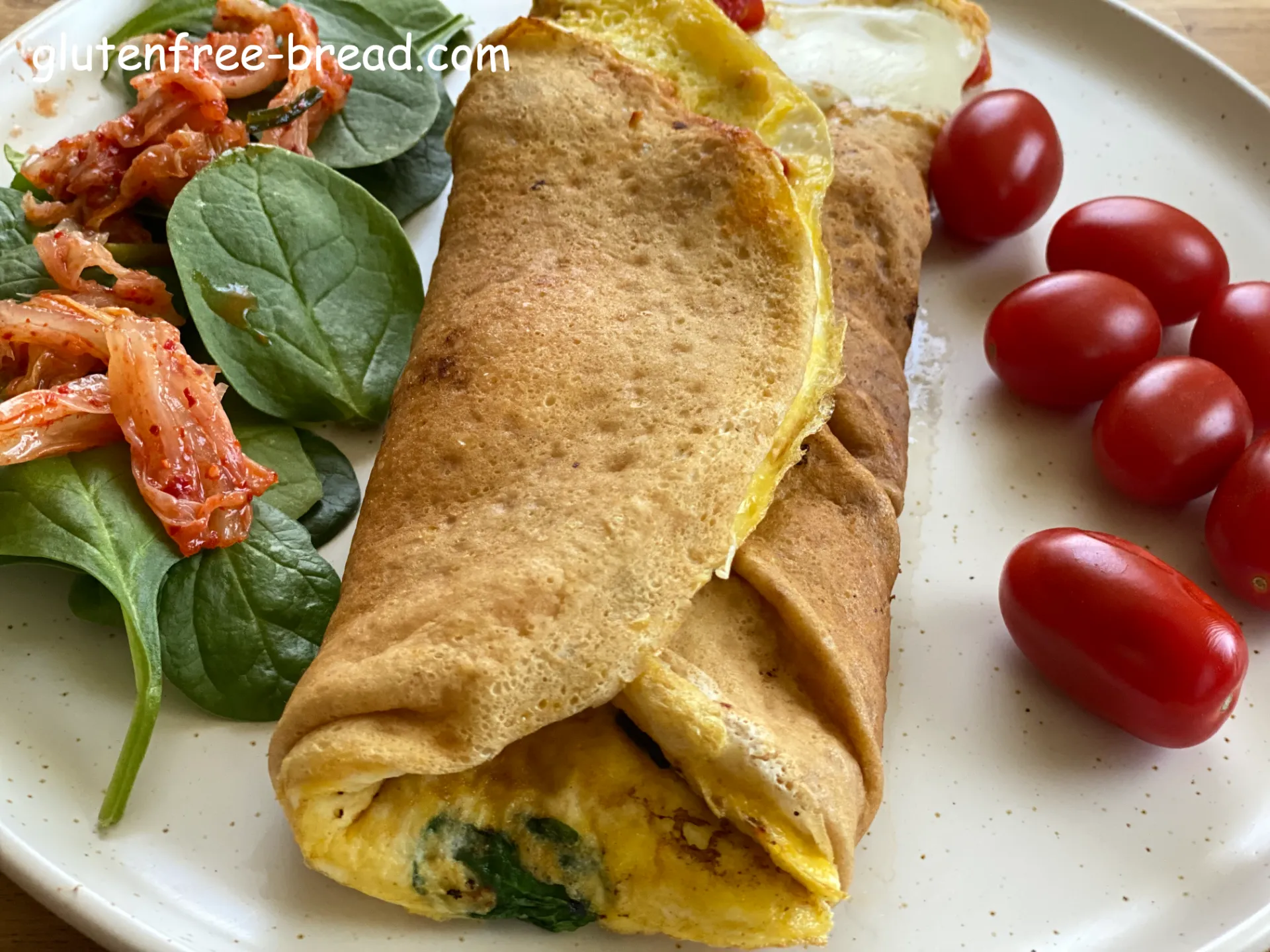
Gluten Free, Low Carbs, Sugar Free, Yeast Free, Oil Free, Nut Free
Ingredients:
| Name | Metric | US | TIP | |
|---|---|---|---|---|
| Oat Flour | 100 gr | 1 cup | ||
| Eggs | 2 | 2 | ||
| Milk/Water | 300 ml | 1 1/4 cups | ||
| Salt | 3 gr | 1/2 teaspoon |
Optional Ingredients for sweet version:
| 3 ml / ½ teaspoon Vanilla | |
| 15 gr / 1 tbsp Sweetener ( Maple Syrup, Honey or Coconut Sugar) | |
| 3 gr / ½ teaspoon Cinnamon |
Equipment:
| Blender | |
| Skillet |
Steps:
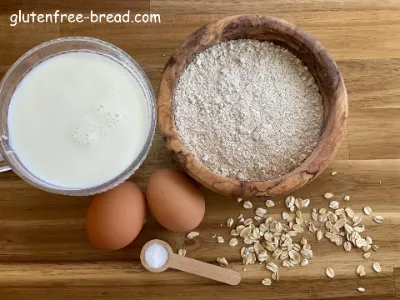
Prepare all the ingredients. Prepare all the ingredients.
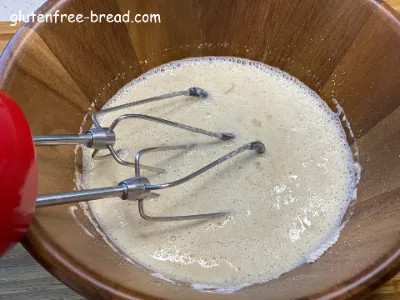
In a high-speed blender put oat flour (100 gr), milk/water (11/4 cups), eggs (2) and salt (½ teaspoon). Blend until smooth. Crepe batter should have the consistency of heavy cream, almost liquid. In a high-speed blender put oat flour (100 gr), milk/water (11/4 cups), eggs (2) and salt (½ teaspoon). Blend until smooth. Crepe batter should have the consistency of heavy cream, almost liquid.
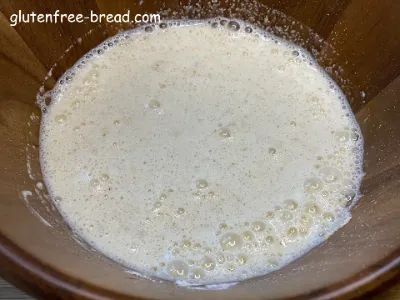
Allow the batter to rest for 10 minutes. Allow the batter to rest for 10 minutes.
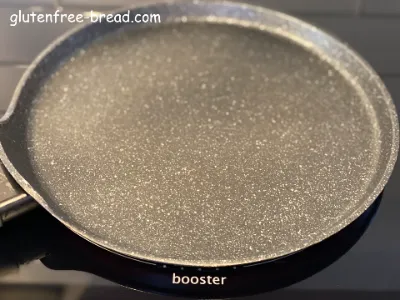
Meanwhile preheat a crepe pan or non-stick skillet over medium heat (for about 5 minutes). This step is very important, so crepes will not stick to the pan! The pan should be heated to medium before adding the batter. If the heat is too high, the batter won’t spread to the edges of the pan before setting. Meanwhile preheat a crepe pan or non-stick skillet over medium heat (for about 5 minutes). This step is very important, so crepes will not stick to the pan! The pan should be heated to medium before adding the batter. If the heat is too high, the batter won’t spread to the edges of the pan before setting.

Brush the pan very lightly with oil. Brush the pan very lightly with oil.
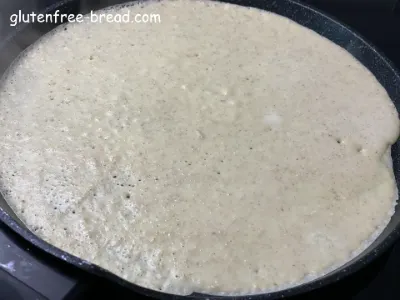
Coat the pan with about 1/3 cup of crepe batter, cook until the edges start to brown, then flip the crepe. Cook for 10 more seconds and remove from the pan. Coat the pan with about 1/3 cup of crepe batter, cook until the edges start to brown, then flip the crepe. Cook for 10 more seconds and remove from the pan.

Continue with the rest of the batter, adjusting heat up or down. Mix crepe batter before pouring each batch into the pan or all the oatmeal flour will run to the bottom of the bowl. Simple solution but very important. You should yield about 8 crepes. Continue with the rest of the batter, adjusting heat up or down. Mix crepe batter before pouring each batch into the pan or all the oatmeal flour will run to the bottom of the bowl. Simple solution but very important. You should yield about 8 crepes.

Transfer the cooked crepes to a large plate and serve with your choice of fillings or toppings! Transfer the cooked crepes to a large plate and serve with your choice of fillings or toppings!
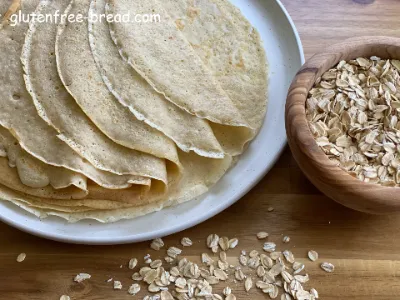
Feel free to get creative and experiment with your favorite ingredients to create personalized crepe fillings that suit your taste preferences. Enjoy experimenting in the kitchen! Feel free to get creative and experiment with your favorite ingredients to create personalized crepe fillings that suit your taste preferences. Enjoy experimenting in the kitchen!
Comments:
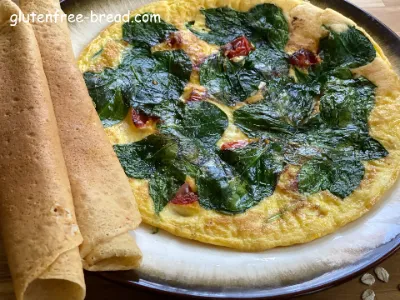
Oatmeal Crepes
Here are some tips for making perfect crepes:
Use the right batter consistency: The crepe batter should be thin, similar to the consistency of heavy cream. If it's too thick, the crepes will be too dense; if it's too thin, they may tear easily.
Let the batter rest: Allow the batter to rest for at least 10 minutes before cooking. This allows the flour/grains to fully hydrate and results in smoother crepes.
Preheat the pan: Preheat a non-stick skillet or crepe pan over medium heat before adding the batter. The pan should be hot enough that a drop of water sizzles and evaporates immediately.
Use the right amount of batter: Pour just enough batter into the pan to thinly coat the bottom when swirled. You can use a ladle or measuring cup to portion out the batter.
Swirl the batter: Once you pour the batter into the pan, quickly tilt and rotate the pan to spread the batter evenly in a thin layer. This helps create a uniform thickness for the crepe.
Cook on one side first: Cook the crepe on one side until the edges start to brown slightly and the surface appears dry, about 1-2 minutes.
Flip carefully: Use a thin spatula to gently lift and flip the crepe. If you're new to making crepes, you can use your fingers to help guide the crepe as you flip it.
Cook briefly on the other side: Cook the crepe on the other side for another 15 seconds or until lightly browned.
Addind baking soda/baking powder:
Adding baking soda to crepe batter is often optional.
If a recipe calls for soda but you prefer not to use it or don't have any on hand, you can often omit it without affecting the outcome of the crepes. The crepes may be slightly denser and may not brown as evenly, but they still will be tasty and perfectly edible.Keep warm: If you're making a large batch of crepes, you can keep them warm by covering the stack with a clean kitchen towel while you finish cooking the rest.
Experiment with fillings: Get creative with your crepe fillings! Sweet options like Nutella, fresh fruit, whipped cream, or jam are classic choices, while savory options like cheese, ham, spinach, or mushrooms can also be delicious.
With practice and patience, you'll be able to master the art of making perfect crepes every time!
Oatmeal Crepes additional information:
Oatmeal flour is derived from oats, a type of cereal grain known for its health benefits and versatility in cooking. Here’s an overview of its origin and processing:
Origin:
Cultivation: Oats (Avena sativa) have been cultivated for thousands of years and are believed to have originated in the Mediterranean region. They are now grown worldwide in temperate regions.
Nutritional Profile: Oats are rich in nutrients such as dietary fiber (including beta-glucan), protein, vitamins (especially B vitamins like thiamine, riboflavin, and folate), minerals (such as manganese, phosphorus, magnesium, and zinc), and antioxidants.
Processing:
Harvesting: Oats are harvested when they reach maturity, typically in late summer. The harvested oats are cleaned to remove any debris or foreign matter.
Milling:
- Whole Oat Groats: The entire oat kernel is called a groat. If the oats are minimally processed, they are called whole oat groats.
- Steel-Cut Oats: Whole oat groats are chopped into smaller pieces with steel blades, resulting in steel-cut oats.
- Rolled Oats: Steel-cut oats can be steamed and then rolled into flakes, creating rolled oats (also known as old-fashioned oats).
- Oatmeal Flour: Oatmeal flour is made by grinding whole oat groats, steel-cut oats, or rolled oats into a fine powder. This grinding process results in oatmeal flour, which retains all parts of the oat kernel, including the bran, germ, and endosperm.
High in Fiber: Oatmeal flour is rich in dietary fiber, including soluble fiber known as beta-glucan. This type of fiber helps to:
- Lower cholesterol levels by binding to cholesterol-rich bile acids in the digestive system and aiding their excretion.
- Promote a feeling of fullness, which can help with weight management and satiety.
Heart Health: The beta-glucan fiber in oatmeal flour has been linked to improved heart health by:
- Helping to reduce blood pressure.
- Supporting healthy blood sugar levels by slowing down the digestion and absorption of carbohydrates.
Rich in Vitamins and Minerals: Oatmeal flour contains various essential vitamins and minerals, including:
- B Vitamins: Thiamine (B1), riboflavin (B2), niacin (B3), and folate (B9), which are important for energy production, metabolism, and overall cellular function.
- Minerals: Such as manganese, phosphorus, magnesium, iron, zinc, and selenium, which play critical roles in bone health, immune function, and antioxidant defense.
Protein Content: Oatmeal flour provides a moderate amount of protein, which is essential for muscle growth, repair, and overall body function.
Antioxidants: Oats contain antioxidants, including avenanthramides, which have anti-inflammatory and potentially protective effects against oxidative stress.
Low Glycemic Index: Oatmeal flour has a lower glycemic index compared to many other grains, meaning it helps stabilize blood sugar levels and provides sustained energy release.
Gluten-Free Option: While oats themselves are naturally gluten-free, cross-contamination during processing is possible. Certified gluten-free oatmeal flour is available for individuals with celiac disease or gluten intolerance.
Digestive Health: The fiber in oatmeal flour supports digestive health by promoting regular bowel movements and maintaining gut health.
Baking:
- Cookies and Bars: Oatmeal flour adds a nutty flavor and chewy texture to cookies, granola bars, and energy bars.
- Muffins and Breads: It can be used in muffins, quick breads, and scones to enhance moisture and provide a hearty texture.
- Pancakes and Waffles: Oatmeal flour can replace part of the wheat flour in pancake and waffle recipes, adding nutritional value and a slightly sweet flavor.
Batters and Coatings:
- Oatmeal flour can be used as a coating for frying or baking foods like chicken tenders, fish fillets, or vegetables, providing a crispy texture and enhancing flavor.
Thickening Agent:
- It can be used as a thickening agent in soups, stews, and sauces. Oatmeal flour thickens gradually and provides a creamy texture without the need for added fats or dairy.
Smoothies and Shakes:
- Oatmeal flour can be blended into smoothies and shakes to add thickness and provide a nutritious boost of fiber and protein.
Porridge and Hot Cereal:
- Oatmeal flour can be used to make quick-cooking porridge or hot cereal by mixing it with boiling water or milk, similar to traditional oats.
Gluten-Free Baking:
- It is a popular choice in gluten-free baking, where it can be used to make bread, cakes, crepes, and other baked goods without wheat flour.
Alternative Flours:
- Oatmeal flour can be combined with other gluten-free flours like almond flour or coconut flour in recipes that require a blend of flours for optimal texture and flavor.
Snacks and Granola:
- Oatmeal flour can be incorporated into homemade granola, energy balls, or snack bars for a nutritious and filling snack option.
Mildly Sweet: Oatmeal flour has a natural, subtle sweetness that enhances its appeal in baked goods and breakfast dishes. This sweetness is more pronounced when the oats are toasted or used in combination with other sweet ingredients.
Nutty and Earthy: It carries a mild nutty and earthy undertone, which adds depth to its flavor profile. This characteristic makes oatmeal flour versatile for both savory and sweet recipes.
Creamy and Porridge-like: When cooked or blended into dishes like porridge or smoothies, oatmeal flour develops a creamy texture that contributes to a comforting eating experience.
Versatile in Flavor Pairings: Oatmeal flour pairs well with a wide range of flavors and ingredients:
- Sweet Pairings: It complements flavors like honey, maple syrup, cinnamon, vanilla, and fruits such as berries and bananas.
- Savory Pairings: Oatmeal flour works well with savory ingredients like cheeses, herbs, garlic, and spices in dishes such as savory muffins or breading for meats and vegetables.
Enhanced by Cooking Methods: The flavor of oatmeal flour can be enhanced through cooking methods such as toasting or simmering, which bring out its natural sweetness and nuttiness.
Gluten Sensitivity: Oatmeal itself is naturally gluten-free, but cross-contamination can occur during processing if oats are processed in facilities that also handle gluten-containing grains like wheat, barley, or rye. Individuals with celiac disease or gluten sensitivity should opt for certified gluten-free oatmeal flour to avoid adverse reactions.
Fiber Content: Oatmeal flour is rich in dietary fiber, which is beneficial for digestive health. However, increasing fiber intake abruptly can sometimes cause digestive discomfort, such as bloating or gas. It's recommended to gradually introduce oatmeal flour into your diet and drink plenty of water to help prevent digestive issues.
Potential for Contamination: As with any grain product, oatmeal flour can be susceptible to contamination with molds or toxins if not stored properly. It's essential to store oatmeal flour in a cool, dry place in an airtight container to maintain its quality and safety.
Processing and Additives: Some commercially available oatmeal flours may contain additives or preservatives to enhance shelf life or texture. Checking ingredient labels can help ensure you're selecting a product with minimal additives, especially if you prefer a more natural option.
Nutrient Density: While oatmeal flour offers various vitamins, minerals, and antioxidants, it is not as nutrient-dense as whole oats or other whole grains. It's beneficial to incorporate a variety of whole grains, fruits, vegetables, and lean proteins into your diet to ensure a balanced nutrient intake.
Moderation in Consumption: Like any food, moderation is key. While oatmeal flour provides numerous health benefits, consuming excessive amounts can lead to an imbalance in nutrient intake or caloric excess. Pay attention to portion sizes and include oatmeal flour as part of a diverse and balanced diet.
Individual Sensitivities: Some individuals may have specific sensitivities or allergies to oats or oat-derived products. If you experience any adverse reactions after consuming oatmeal flour, such as digestive discomfort, skin reactions, or respiratory issues, it's advisable to consult with a healthcare professional for personalized guidance.
- Rolled oats or quick oats (certified gluten-free if needed)
Choose Your Oats:
- You can use either rolled oats or quick oats to make oatmeal flour. Rolled oats will give a slightly coarser texture, while quick oats will yield a finer flour.
Blend the Oats:
- Add the oats to a blender or food processor. Start with a small batch to ensure even grinding.
Grind Until Fine:
- Process the oats until they reach a fine, flour-like consistency. This may take a few minutes, depending on the power of your blender or food processor.
Sift (Optional):
- If you prefer a finer texture, you can sift the oat flour through a fine mesh sieve to remove any larger pieces that didn't grind completely.
Store Properly:
- Transfer the oatmeal flour to an airtight container or jar and store it in a cool, dry place. Use it within a few weeks for optimal freshness.
- Batch Size: It's best to grind oats in small batches to ensure even consistency.
- Texture Preference: Adjust the grind time based on your desired texture. For baking, a finer grind may be preferable, while a slightly coarser grind can add texture to certain recipes.
- Gluten-Free Consideration: If you require gluten-free oatmeal flour, ensure that you use oats labeled as gluten-free, as cross-contamination can occur during processing.
Nutritional benefits:
Incorporating oatmeal flour into a balanced diet can provide numerous health benefits, ranging from heart health and improved digestion to supporting overall well-being and energy levels. It can be used in a variety of recipes, from baking to thickening sauces, offering both nutritional value and culinary versatility.
Culinary uses:
Overall, oatmeal flour adds a wholesome and nutritious element to a wide variety of dishes, enhancing both flavor and texture while providing health benefits such as fiber, vitamins, minerals, and antioxidants. Whether used as a main ingredient or as part of a flour blend, oatmeal flour is a versatile addition to any kitchen.
Flavor profile:
Oatmeal flour's mild sweetness, nutty undertones, and creamy texture make it a versatile ingredient suitable for a wide range of recipes, from baked goods to savory dishes and beyond. Its flavor profile adds depth and richness to dishes while providing nutritional benefits, making it a favored choice in both traditional and modern culinary practices.
When considering the health aspects of oatmeal flour, there are several important considerations to keep in mind:
Overall, oatmeal flour is a nutritious and versatile ingredient that can contribute to a healthy diet when used mindfully and in moderation. It offers fiber, vitamins, minerals, and other beneficial compounds that support digestive health, heart health, and overall well-being. By choosing high-quality, certified gluten-free oatmeal flour and incorporating it into a balanced diet, you can enjoy its health benefits while minimizing potential risks.
Homemade Oatmeal Flour Recipe:
Ingredients:
Instructions:
